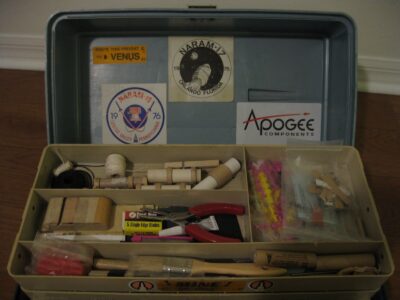
Creating a checklist for your model or high-powered rocket range/launch toolbox ensures safe and successful launches. Here's a comprehensive list of items you should consider including:
Safety Equipment
- Safety Glasses: To protect your eyes from possible debris.
- Ear Protection: This is especially important for high-powered launches.
- Gloves: Heat-resistant gloves for handling motors and recovery systems.
- First Aid Kit: For handling minor injuries on-site.
Rocket Assembly Tools
- Screwdrivers: Various sizes, both flathead and Phillips.
- Pliers: Needle-nose and standard pliers.
- Wire Cutters: For trimming leads or cutting recovery harnesses.
- Hobby Knife: Useful for trimming and cutting materials.
- Ruler or Measuring Tape: For precise measurements.
- Soldering Iron and Solder: If you are dealing with electronics.
Launch Equipment
- Launch Pad: Appropriate for the size of your rockets.
- Launch Controller: Reliable controller with safety interlock.
- Igniters: Extra igniters for your rocket motors.
- Battery for Launch Controller: Ensure it's fully charged or bring spares.
Rocket Motors and Propulsion
- Rocket Motors: Appropriate motors for your rockets.
- Motor Mounting Hardware: Retainers, screws, etc.
- Motor Ignition Tools: These are such as starters or electronic matches.
- Propellant (if applicable): For reloadable motors.
Recovery System Components
- Parachutes: Ensure they are appropriately sized for your rockets.
- Shock Cords: Extras in case of damage.
- Wadding/Ejection Charge Material: To protect the parachute from heat.
Electronics (if used)
- Altimeters: For measuring altitude and controlling dual deployment.
- Batteries for Electronics: Spare batteries.
- GPS Tracker: For recovering high-altitude flights.
- Telemetry Equipment: If you are recording flight data.
Miscellaneous
- Field Repair Supplies: Duct tape, super glue, epoxy, zip ties.
- Notebook and Pen: For recording flight data and notes.
- Sun Protection: Hat, sunscreen, sunglasses.
- Water and Snacks: Stay hydrated and energized.
- Seating: Folding chair or stool for comfort.
- Weather Monitoring Tools: Wind meter, thermometer.
- Camera or Video Equipment: If you wish to record your launches.
Storage and Transport
- Toolbox or Storage Container: To keep everything organized.
- Rocket Stand or Holder: For prepping rockets at the field.
Before You Leave
- Check the Weather Forecast To ensure favourable launch conditions.
- Launch Site Permission: Confirm access to the launch site.
- Review Club/Site Rules: If launching with a club or at a public site.
- Flight Plan: Pre-plan your launches and objectives.
Remember, this list can be adjusted based on the specific requirements of your rockets and the launch site. Safety should always be your top priority. Happy launching!
What else can you think of?
Even with a checklist, I always seem to forget something,
I have just finished watching the Apogee video, and I can already think of a few more items.
I see that Tim has discovered the same method of packing that I also use. 😀 😀
What do you usually forget?
Hi,
Looking through this list, there's a mixture of what's in my range / rocketry box, the tool boxes and everything else I throw in the car to make the morning enjoyable. A couple of things I would add which seem to be missing;
- Sandpaper - of various finer grades. Great for making the cardboard tubes in the reload kits just that little less, "snug".
- Masking tape - comes in useful.
- Talcum powder - for making sure the parachute doesn't stick to it's self.
- Digitial Multimeter - For dealing with any electronics issues it is great to have voltage and continuity testing.
- A collapsible table - The chairs are listed above but I have a great cheap table I purchased for field work (full time employment type of work) many years ago which is great for this.
- Gazebo - One of the purchases I have never regretted. Simple shade and sun protection.
- Mallet - For the pegs used on the Gazebo above.
- Laptop - So I can rerun OpenRocket simulations with the prevailing conditions when I get there, or with the motors which are available.
- Launch Checklists - Although I am going all digital on my electronic notepad.
- A healthy level or resilience and appreciation for rocket science - for when your rocket fails spectacularly but the 10 year old's more complicated rocket performs perfectly.
@simonfryer Love the additions, not sure how masking tape could have been left off the original list???
There is still one more critical item to add:
- insect repellant
Tripoli #13468 L3
Tripoli Prefect #131
QRS President
@crom and Its always handy to have a small spade/trenching tool and gardening tools for digging out the occasional lawn dart!
AMRS Level 1 - PML Callisto May19 H100W 3600ft
AMRS/Tripoli Level 2 - 3" AGM33 Pike Aug20 J270W 3300ft
First Airstart - Thales Starstreak Mar22
First Cluster - Banana Republican Jun23 3xE20 1856ft
Impulse tally - 11,019NS since May 2019
That could never happen at one of our launches.
(OOPS!)

